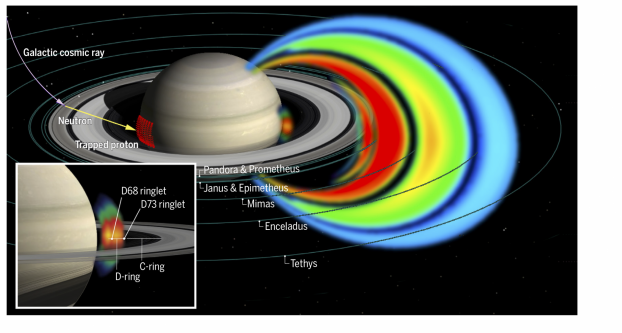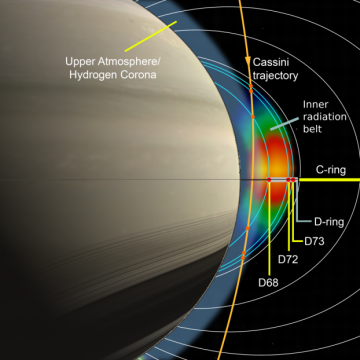Saturn: Cassini discovers a new radiation belt
About one year ago, a spectacular dive into Saturn’s upper atmosphere put an end to the Cassini mission, a unique project that studied the Saturn system for 13 years. During the last five months of the mission, the probe dived 22 times into the hitherto almost unexplored region, located between the planet and its innermost ring, ring D. Science magazine has just published a series of articles describing the first results of this last phase of the mission. In one of these articles, an international research team, involving the Institut de Recherche en Astrophysique et Planétologie (IRAP / OMP, CNRS / University of Toulouse III Paul Sabatier), shows that a radiation belt, containing protons of extreme energies, is formed between the planet and its dense rings. As with the main proton belt, the protons that populate the region near the planet are generated by the incoming cosmic radiation. Due to the presence of the particularly dense rings A, B and C, this zone is decoupled from the main radiation belt as well as from the rest of the magnetosphere.

When the Cassini spacecraft entered orbit around Saturn on July 1, 2004, the particle detector suite of the MIMI (Magnetospheric Imaging Instrument) experiment, to which IRAP contributed, had a brief overview of the region between the planet and ring D (the most internal). The measurements had indicated that a population of charged particles could be present, but its composition and properties remained unclear. In the following years, the MIMI experiment studied the particles trapped by Saturn’s magnetic field outside the rings, forming the main radiation belt which is composed of protons and high-energy electrons. The protonic radiation belt is strongly influenced by Saturn’s many moons, which segment it into five sectors. “Only 13 years later we had the opportunity to follow our very first measurements at Saturn and see if an additional sector of the radiation belt coexisted with the D-ring and the upper atmosphere of the planet,” explains Elias Roussos, MPS researcher and lead author of the study.
As with Saturn’s main proton belt, the protons that populate the region near the planet are generated by incident cosmic radiation. When this radiation interacts with materials in Saturn’s atmosphere or rings, it triggers a chain of reactions that generates high-energy protons, which are then trapped by the planet’s magnetic field. “Cosmic radiation and rings “collaborate” to create this tiny but highly energetic radiation belt,” adds Anna Kotova, an IRAP researcher and one of the main co-authors of the study.
Saturn’s magnetic field near the planet is so intense that it makes proton trapping extremely effective and they interact permanently with the D-ring and the Saturn atmosphere. Measurements of the experiment revealed a stable accumulation of energetic protons that extends from Saturn’s atmosphere to the entire D-ring. The energy available to some of these protons is extreme. In the solar system, this region is unique.
As a result of the MIMI measurements, a secondary radiation belt, formed by protons of lower energy and located at a lower altitude, was also discovered. This belt is formed when fast neutral hydrogen atoms, created in Saturn’s magnetosphere, are ionized and trapped near the planet. “This low altitude belt was only briefly observed in 2004. We had to wait 13 years to repeat these measurements and validate our theories on the physical processes responsible for this belt,” says Iannis Dandouras, IRAP researcher and co-investigator of the MIMI team.
During the 13 years spent in Saturn, the MIMI experiment, developed in collaboration between Johns Hopkins University, the Max Planck Institute, the University of Maryland and IRAP, has been one of the most comprehensive ways to study a giant planetary magnetosphere and its radiation belts, which is a special case in our solar system.

Further Resources
- Article : Elias Roussos, Peter Kollmann, Norbert Krupp, Anna Kotova, Leonardo Regoli, Chris Paranicas, Donald Grant Mitchell, Stamatios M. Krimigis, Douglas Hamilton, Pontus Brandt, James Carbary, Steve Christon, Kostas Dialynas, Iannis Dandouras, Matthew Hill, Wing-Huen Ip, Geraint Jones, Stefano Livi, Barry Mauk, Benjamin Palmaerts, Edmond Roelof, Abigail Rymer, Nick Sergis, Thomas Smith (2018) A radiation belt of energetic protons located between Saturn and its rings, Science, doi: 10.1126/science.aat1962
IRAP Contact
- Iannis Dandouras, Institut de Recherche en Astrophysique et Planétologie (IRAP / OMP, CNRS / Université Paul Sabatier-Toulouse III), iannis.dandouras@irap.omp.eu, 05 61 55 83 20






